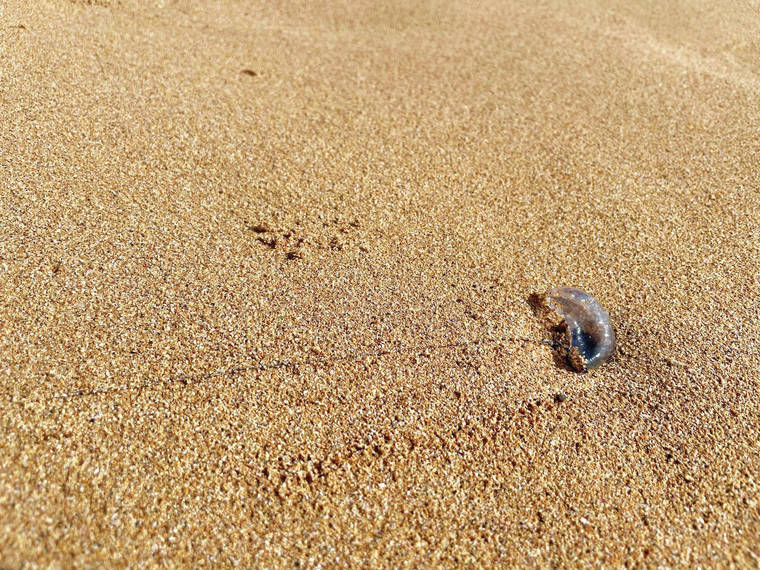KEALIA —Last Saturday, Katie Guastella, an Intensive Care Unit (ICU) nurse at Kauai Veterans Memorial Hospital (KVMH) on the Westside, discovered a group of Portuguese man-o-war (jelly-fish like sea creatures) on her day off at Kealia Beach, after the heavy showers of rained passed.
“I saw tons of the Portuguese man-o-war,” Guastella said. “I’ve heard of them and box jellies coming to Kaua‘i at times, but never actually saw it until this day. There was one every 5 feet or so, all over the beach, hundreds within view. I’m in the water a few days per week, but I’ve never been stung before, hoping to keep that going.”
Although Guastella was fortunate not to get stung last week at Kealia Beach, she said her friend wasn’t that lucky.
“I haven’t seen any any other day, but I also haven’t been to Kealia since,” Guastella said “I had a friend swimming up north a couple months ago, all of a sudden she must have been in a swarm of them, she came out and it looked like whip marks all over her body. They got her good. I swim south/ west a few times per week and haven’t seen one there ever.”
Portuguese man-o-war often look like blue jelly fish, and sizes varies but can be as small as the size of a quarter. They spend most of their lives floating in the oceans’ waves until they drift unto the shorelines of a beach and a beachgoer may step on them, causing them immediate pain from the sting of the Portuguese man-o-war.
Gary Ueunten an environmental health specialist with the Department Of Health Kauai District Health Office said the department has no recommendations regarding emergency care after being stung, however, he pointed out that the City and County of Honolulu had more information.
Myron Honda the Monitoring Section Supervisor on Oahu shared the City and County of Honolulu’s Emergency Services Department (CCHESD) on when Portuguese man-of-war are mostly found.
“Portuguese man-o-war are most commonly found along bays and beaches during strong onshore winds,”CCHESD said. “They are high in number when winds blow in from the ocean onto land, so beach-goers are urged to observe posted signs.”
If a person gets stung by a Portuguese man-war CCHESD shared how to handle to recognize the symptoms and what to do next.
“Symptoms of a sting include stinging, burning, redness, swelling of lymph nodes,” CCHESD said. “If stung carefully pick off any visible tentacles. Rinse with fresh or salt water. Apply ice for pain. Immediate medical attention may be required for severe reactions.”
Global folk remedies include vinegar, urine or green papaya to relieve the pain of the sting and take out any poison left from the sting.



Hot water works like a charm, to halt the pain of porcho stings! Place a bottle of water in the sun to heat b4 you swim.
My son was stung when he was a young child. A nice bystander at the beach told us to make a paste of alcohol and meat tenderizer, and apply it to the stings. It relieved the pain almost instantly.
I think I saw one washed up on the shore today in Haena. It’s mostly clear with some purple (but the purple didn’t have the clean shape of a moon jellyfish). I didn’t check for tentacles.
It would make sense they might show up today given the stormy weather. Anyone else seeing anything?